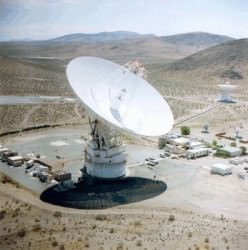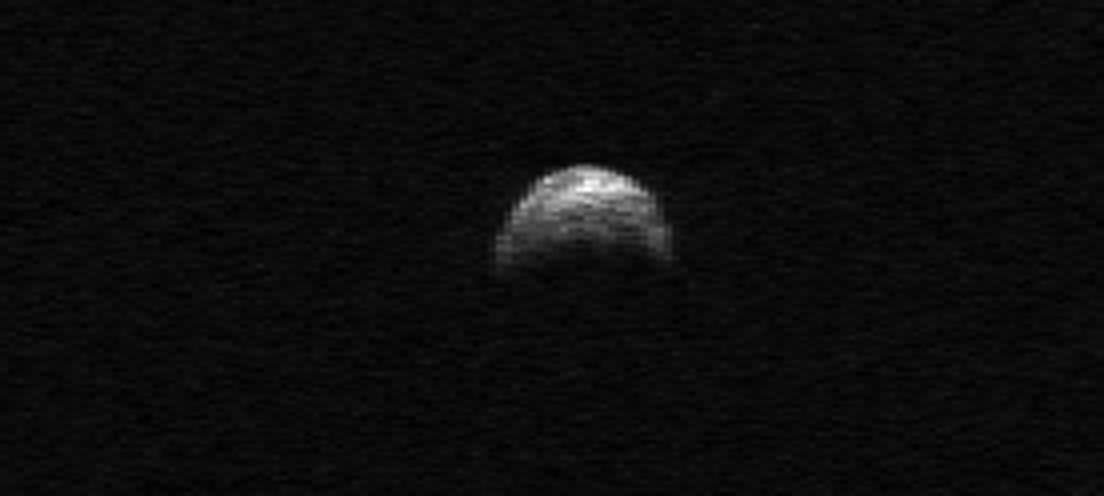[/caption]
On Tuesday, November 8, at 6:28 p.m. EST, an asteroid the size of an aircraft carrier will soar past our planet at a distance closer than the Moon… and NASA scientists will be watching!
2005 YU55, a 400-meter (1,300-foot) -wide C-type asteroid, was discovered in December 2005 by Robert McMillan of the Spacewatch Program at the University of Arizona, Tucson. It’s pretty much spherical in shape and dark – darker than charcoal, in fact! Scientists with NASA’s Near-Earth Objects Observation Program will begin tracking it on November 4 using the 70-meter radar telescope at the Deep Space Network in Goldstone, California , as well as with the Arecibo Planetary Radar Facility in Puerto Rico beginning November 8. They will continue tracking 2005 YU55 through November 10.

YU55’s orbit is well understood by scientists. It has come this way before, and although this is the closest it’s come to Earth in at least two centuries it will still be at least 324,600 kilometers (201,700 miles) away at nearest approach. That’s about 85% of the distance to the Moon.
It will approach from the sunward side, making viewing in visible light difficult until after it’s made its closest pass.
Other than the excitement it will most likely cause amongst radar astronomers, 2005 YU55 will have no physical effect on our planet. (There have been some rumors circulating online about this particular asteroid’s upcoming pass, in regards to earthquakes and tidal fluctuations and atmospheric disturbances and other such nonsense… the bottom line is that, like the ill-fated comet Elenin, 2005 YU55 has never been known to pose any threat to Earth.)
“YU55 poses no threat of an Earth collision over, at the very least, the next 100 years,” said Don Yeomans, manager of NASA’s Near-Earth Object Program Office at JPL. “During its closest approach, its gravitational effect on the Earth will be so miniscule as to be immeasurable. It will not affect the tides or anything else.”

Scientists are very eager though to have a prime opportunity to study this quarter-mile-wide world as it makes its closest pass. The giant telescopes at Goldstone and Arecibo will bounce radar waves off the asteroid, mapping its size and shape, and hopefully obtain some very high-resolution images.
“Using the Goldstone radar operating with the software and hardware upgrades, the resulting images of YU55 could come in with resolution as fine as 4 meters per pixel. We’re talking about getting down to the kind of surface detail you dream of when you have a spacecraft fly by one of these targets.”
– Lance Benner, JPL radio astronomer
Even though YU55 will remain at a safe distance the event is still quite notable. The last time an object this large came so close to Earth was in 1976… and scientists weren’t even aware of it at the time. Luckily we now have programs like the Near-Earth Objects Observations Program – a.k.a. “Spaceguard” – to identify asteroids like this, hopefully in time to know if they could become a danger to our planet in either the near or distant future.
As of now, no large space rock with Earth’s name on it has been positively identified… but that doesn’t mean there’s nothing out there either. We need to keep diligent, keep looking and, above all, keep funding programs like this. If anything, this pass should serve as a reminder – however harmless – that we certainly are not alone in the solar system!
Read more on the NASA/JPL press release here.
UPDATE: NASA will be holding a live Q&A on 2005 YU55 and other near-Earth objects on November 1 at 2:30 p.m. PDT (5:30 p.m. EDT)… watch live here.

